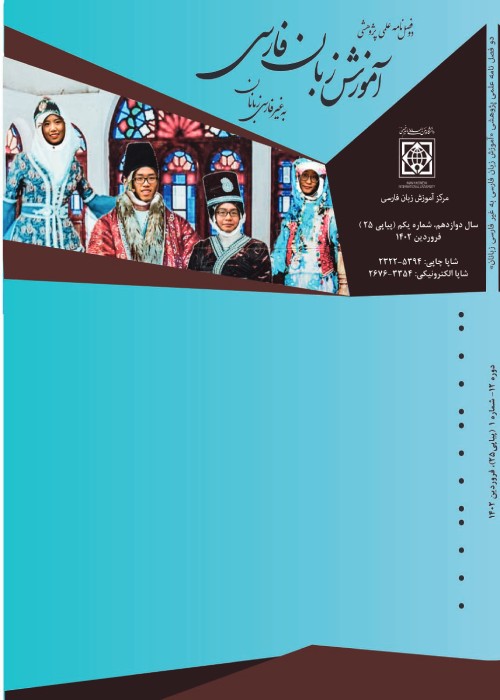The Effect of Persian and Arabic Word Order Typological Features on Arabic Learners Learning Persian
Learning second language grammar is one of the main problems with which language learners are faced. In this research, through using achievements of language typology, it was tried to facilitate learning of Persian grammar for Arabic learners. For this purpose, on the basis of the typological word order parameters, typological similarities and differences between the standard Persian and Arabic languages were determined. The data analysis which we gathered showed that from the 24 common parameters of the standard Persian and Arabic languages, they are similar in 12 parameters and they are different in 7 parameters. By explaining these differences and similarities to the subjects, the grammar topics of Persian language were taught to them and then they were subjected to post-test. The mean score of the tests showed that the average scores of the subjects in the post -test were higher than their mean scores in the pre-test. Inferential statistics analysis also showed that the difference in the score of the subjects in the pre-test and post-test is significant as well. Therefore, it can be said that by more awareness of Arabic learners from the typological similarities and differences between Persian and Arabic languages, their Persian language learning process becomes easier and faster. Extended Abstract: Linguistics research shows that similarities can be a source of making mistakes. In other words, if a learner learns a language which is totally different or similar, he or she is less likely to make mistakes. However, for languages such as Arabic and Persian which have some features in common, but they are not completely similar or different, these similar features happen to be source of mistakes. Considering in syntax, typology made considerable progress, this article is aimed at determining how much applied use of typological features of word order dealing with syntax has an impact on teaching and learning Persian by Arabic learners. Dryer, in his article ‘The Greenbergian Word Order Correlations’ (1992), studied on the one hand the correlation between verb and object order and on the other hand particular pairs order. He used ‘correlation pairs’ to refer to these pairs and defined them as follows: if the sequence of a pair x and y shows the sequence of verb and object sequence respectively, then x and y are a correlation pair and in this pair, x is verb patterned and y is object patterned. Dryer explained 23 correlation pairs in an independent table. 5 of them do not have equivalent in Persian. Therefore, they are not considered in the article. There are 6 other correlations which are not mentioned in his article but in his data base. Among the aforementioned features, Dabir Moghaddam exploits 24 features to determine Persian typology. In addition to 23 Dryers’ features, I use 6 features added to Dryers’ data base by Dabir Moghaddam to study Arabic. These features come to 25, after setting aside four features applicable in Arabic (2 features of 23 Dryers’ features and 2 features of Dabir Moghaddam features). 1) Ad position type 2) Order of noun and relative clause 3) Order of noun and genitive 4) Order of adjective and standard in comparative construction 5) Order of verb and adpositional phrase 6) Order of verb and manner adverb 7) Order of copula and predicate 8) Order of want + verb 9) Order of noun and adjective 10) Order of demonstrative and noun 11) Order of intensifier and adjective 12) Order of verb and negative particle 13) Order of verb and tense /aspect particle 14) Order of verb and tense /aspect auxiliary verb 15) Order of question particle and sentence 16) Order of adverbial subordinator and clause 17) Order of article and noun 18) Order of verb and subject 19) Order of numeral and noun 20) Order of tense-aspect affix and verb stem 21) Order of possessive affix and noun 22) Order of content verb and auxiliary verb(s) meaning to be able to 23) Order of complementizer and complement sentence 24) Wh-movement 25) Order of verb and object. This article aims to first determine typological features of Persian and Arabic using typological word order. Secondly, similarities and differences are determined through contrastive analysis. Thirdly, without mentioning the similarities and differences of Arabic and Persian, given grammatical rules are given to subjects and then are tested (pretest). Finally, after one month, the aforementioned rules are taught by Persian and Arabic typological similarities and differences and then they are tested post test Eleven educated people studying different majors who was learning Persian were tested. There some points need to be mentioned. First, their mother tongue was Arabic, second, they were Arabian. Third, since the research was carried out in The Persian Language Center for Non-Farsi Speakers and this center, we were faced with limited learners, as a result, the method of sampling was limited sampling. Also, the criteria for selecting the subjects were as follows; the subject were native Arabic speakers and being at pre intermediate and intermediate levels. Because of limitation, to carry out the research, we selected eleven subjects. Testes were set on the base of similarities, differences and typological features of Persian and Arabic. In fact, this article tries to include typological features which are different and similar between the two languages and the feature only is found in one language is ignored. The test consisted of three parts, first, the subjects were given Arabic sentences and asked to answer multiple choices. Second, they were asked to translate Arabic sentences into Persian. Third, they were asked to translate a test in Arabic into Persian. Conclusion According to subjects’ average scores, their score in after test (16/10) is higher than that of in pretest (10/57). In addition, the analysis of inferential statistic shows that the difference is considerable meaning that the independent variable, awareness of typological features of Persian and Arabic, has an impact on dependent variable, subjects’ scores, as it were, being aware of these features (similarities and differences) could get a better score. So, the more Arabic learners are aware of similar and different typological features of Persian and Arabic, the easier they can learn Persian especially its grammar. In doing so, this article connecting typology to teaching languages proves that achievements of typology can be used to optimize and facilitate teaching language.
- حق عضویت دریافتی صرف حمایت از نشریات عضو و نگهداری، تکمیل و توسعه مگیران میشود.
- پرداخت حق اشتراک و دانلود مقالات اجازه بازنشر آن در سایر رسانههای چاپی و دیجیتال را به کاربر نمیدهد.



